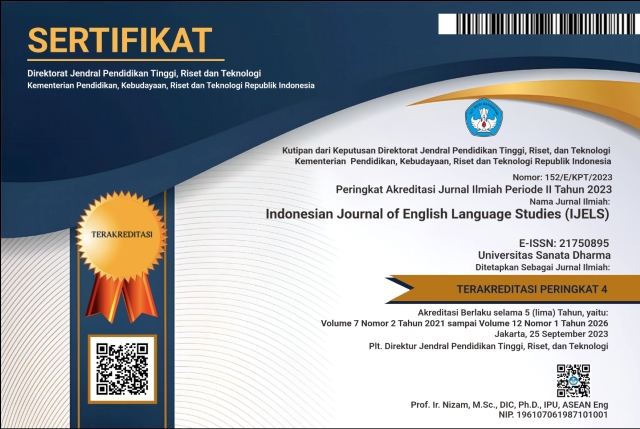Semantic Structure of the Indonesian ‘Die’ Verbs
(1) Yogyakarta State University, Indonesia
(*) Corresponding Author
Abstract
This article focuses on the analysis of the semantic structure of the Indonesian ‘die’ verbs. The lexicon variations for the Indonesian ‘die‘ verbs depend on to whom and in what way it is perceived when it happens. The Indonesian ‘die’ verbs have their meaning which can be expressed through the study of the Natural Semantic Metalanguage (NSM) theoretical framework developed by Goddard and Wierzbicka (2013). The method used is a descriptive method with a qualitative research form. The data analysis technique used four steps including determining the semantic prime, looking for the derivation of meaning, determining polysemy based on the object, and paraphrasing meaning. To analyze the meaning of ‘die’ in Indonesian, the data used in this article were collected from the entry word 'mati' obtained from the dictionary https://kbbi.kemdikbud.go.id/entri/mati. The results showed that there were 17 lexicons (meninggal dunia, tutup usia, wafat, berpulang, gugur, mangkat, berlalu, berkalang tanah, berputih tulang, dipanggil Tuhan, mati, mampus, tewas, binasa, koit, modar, and jangkang) reffering to the ‘die’ concept, which were then grouped into two categories based on the entity and the result of which the ‘die’ concept was implemented.
Keywords
Full Text:
PDFReferences
Adib, H. (2021). Perca-perca bahasa: Kumpulan esai. Yogyakarta: DIVA Press.
Ariana, I. P., & Sulatra, I. K. (2019). Verba lempar Bahasa Bali: Kajian metabahasa semantik alami. SPHOTA: Jurnal Linguistik dan Sastra, 11(2), 41-48. https://doi.org/10.36733/sphota.v11i2.1208
Chaer, A. (2013). Pengantar semantik Bahasa Indonesia. Jakarta: Rineka Cipta.
Collins English Dictionary. (n.d.). Die. Retrieved from https://www.collinsdictionary.com/dictionary/english/die
Dewi, S. S., & Pujiono, M. (2019). Struktur semantis verba kiru ‘Potong’ kajian metabahasa semantik alami. IZUMI, 8(2), 101-124. https://doi.org/10.14710/izumi.8.2.101-124
Goddard, C. (2008). Natural semantic metalanguage: The state of the art. Cross-linguistic semantics, 102, 1-34.
Goddard, C. (2012). Semantic primes, semantic molecules, semantic templates: Key concepts in the NSM approach to lexical typology. Linguistics, 50(3), 711-743. https://doi.org/10.1515/ling-2012-0022
Goddard, C. (2018). Minimal English for a global world. Cham: Palgrave Macmillan. https://doi.org/10.1007/978-3-319-62512-6
Goddard, C., & Wierzbicka, A. (2007). NSM analyses of the semantics of physical qualities: Sweet, hot, hard, heavy, rough, sharp in cross‑linguistic perspective. Studies in Language. International Journal sponsored by the Foundation “Foundations of Language”, 31(4), 765-800.
Goddard, C., & Wierzbicka, A. (2013). Words and meanings: Lexical semantics across domains, languages, and cultures. Oxford: Oxford University Press.
Goddard, C., & Wierzbicka, A. (2014). Words and meanings. Oxford: Oxford University Press.
Goddard, C., & Wierzbicka, A. (Eds.). (2002). Meaning and universal grammar: Theory and empirical findings (Vol. 2). Amsterdam: John Benjamins Publishing Company https://doi.org/10.1075/slcs.60
Goddard, C. (2018). Ten lectures on natural semantic metalanguage: Exploring language, thought and culture using simple, translatable words. Leiden: Brill. https://doi.org/10.1163/9789004357723
Kamus Besar Bahasa Indonesia (KBBI) dalam jaringan. Retrieved from https://tesaurus.kemdikbud.go.id/tematis/lema/mati/verba.
Kridalaksana, H. (2013). Kamus linguistik (4th ed.). Jakarta: Gramedia Pustaka Utama.
Mulyadi, M. (2000). Struktur semantis verba penglihatan dalam Bahasa Indonesia. Linguistik Indonesia, 18(2), 77-89.
Mulyadi, M. (2010). Verba emosi statif dalam Bahasa Melayu Asahan. Linguistika, 17(33), 168-176. https://doi.org/10.13140/RG.2.1.4646.1042.
Mulyadi, M., & Siregar, R. K. (2006). Aplikasi teori metabahasa makna alami dalam kajian makna. Logat Jurnal Ilmiah Bahasa dan Sastra, 2(2). 69-75.
Parwati, S. A. P. E. (2018). Verba" Memasak" dalam Bahasa Bali: Kajian metabahasa semantik alami (MSA). Aksara, 30(1), 121-132.
Sudipa, M. H. D., Laksana, I. K. D., & Rajeg, I. M. (2019). struktur semantis verba ‘naik’dalam Bahasa Jepang. Linguistika: Buletin Ilmiah Program Magister Linguistik Universitas Udayana, 25(2), 156-163.
Syahputra, F. P., & Sinar, T. S. (2018). Struktur semantis verba sentuh Bahasa Indonesia. Haluan Sastra Budaya, 2(1), 77-89. https://doi.org/10.20961/hsb.v2i1.17484
Syifa, R. D., & Subiyanto, A. (2022). Semantic structure of Javanese verb ‘to cut’: Natural semantics metalanguage analysis. Lingua Didaktika: Jurnal Bahasa dan Pembelajaran Bahasa, 16(1), 64-73.
Thompson, R. G., Ahenkorah, C., & Amoako, W. K. (2022). Natural semantic metalanguage of Akani. Journal of West African Languages, 49(1), 46-66.
Utami, N. H., Nasution, N., & Mulyadi, M. (2022). Struktur semantik verba penglihatan dalam Bahasa Mandailing. Disastra: Jurnal Pendidikan Bahasa dan Sastra Indonesia, 4(2), 176-186. http://dx.doi.org/10.29300/disastra.v4i2.5943
Wierzbicka, A. (1996). Semantics: Primes and universals: Primes and universals. Oxford: Oxford University Press.
DOI: https://doi.org/10.24071/ijels.v9i2.5681
Refbacks
- There are currently no refbacks.

This work is licensed under a Creative Commons Attribution-ShareAlike 4.0 International License.
IJELS Journal Sinta 4 Certificate (S4 = Level 4)
We would like to inform you that Indonesian Journal of English Language Studies (IJELS) has been nationally accredited Sinta 4 by the Ministry of Education, Culture, Research and Technology of the Republic of Indonesia based on the decree No. Surat Keputusan 152/E/KPT/2023. Validity for 5 years: Vol 7 No 2, 2021 till Vol 12 No 1, 2026

This work is licensed under CC BY-SA.
Creative Commons Attribution-ShareAlike 4.0 International License
IJELS e-ISSN 2715-0895; IJELS p-ISSN 2442-790X
Indonesian Journal of English Language Studies (IJELS) is published twice a year, namely in March and September, by the English Language Studies (ELS) of the Graduate Program of Sanata Dharma University, Yogyakarta, Indonesia.


 IJELS p-ISSN:
IJELS p-ISSN: 











